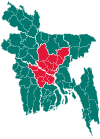Giasuddin Islamic Model College
Geography
Narayanganj Sadar is located at 23°36′00″N 90°30′00″E / 23.6000°N 90.5000°E. It has 476,148 households and total area 100.74 km.
Demographics
According to the 2022 Census of Bangladesh, Narayanganj Sadar Upazila had 476,148 households and a population of 1,770,734. The average household size was 3.65. Narayanganj Sadar had a literacy rate (age 7 and over) of 80.59%, compared to the national average of 74.80%, and a sex ratio of 108.64.
As of the 1991 Bangladesh census, Narayanganj Sadar has a population of 604561. Males constitute 55.89% of the population, and females 44.11%. This Upazila's eighteen up population is 339155. Narayanganj Sadar has an average literacy rate of 49.6% (7+ years), and the national average of 32.4% literate.
Administration
Narayanganj Sadar Upazila is divided into 10 Union Parishads and a City Corporation.
- Union Parishads
- Alirtek
- Baktaboli
- Enayetnagar
- Fatullah
- Gognagar
- Kashipur
- Kutubpur
- Siddhirganj (defunct)
- Sumil Para (defunct)
The union parishads are subdivided into 56 mauzas and 132 villages.
- City Corporation
Narayanganj City Corporation is subdivided into 27 wards.
Upazila Chairman :Anowar Hosen (from Awami League)
Woman Vice Chairman: Ms Fatema Monir (from Awami League)
Vice Chairman : Nazim Uddin (from Awami League)
Upazila Nirbahi Officer (UNO) : Md.Gausul Azam [2] [3]
Education
There are twelve colleges in the upazila. They include honors level colleges Haji Misir Ali University College, Narayanganj College, and Narayanganj Government Mohila College. Government Tolaram College, founded in 1937, is the only masters level college.
According to Banglapedia, Adarsha Girls' School and College, Narayanganj govt. Technical School and college, Deobhog Hazi Uzir Ali High School (founded in 1924), Morgan Girls High School (1910), Adarsha School Narayanganj (1906), Narayanganj Government Girls' High School, Narayanganj Ideal School (2000) and Narayanganj High School and College (1885) are notable secondary schools.
The madrasa education system includes three fazil madrasas and one kamil madrasa.
See also
References
- ^ National Report (PDF). Population and Housing Census 2022. Vol. 1. Dhaka: Bangladesh Bureau of Statistics. November 2023. pp. 387, 399. ISBN 978-9844752016.
- ^ "Bangladesh Postal Code". Dhaka: Bangladesh Postal Department under the Department of Posts and Telecommunications of the Ministry of Posts, Telecommunications and Information Technology of the People's Republic of Bangladesh. 19 October 2024.
- ^ Ruhul Amin Prodhan (2012), "Narayanganj Sadar Upazila", in Sirajul Islam and Ahmed A. Jamal (ed.), Banglapedia: National Encyclopedia of Bangladesh (Second ed.), Asiatic Society of Bangladesh
- ^ Population and Housing Census 2022 - District Report: Narayanganj (PDF). District Series. Dhaka: Bangladesh Bureau of Statistics. June 2024. ISBN 978-984-475-281-8.
- ^ "Bangladesh Population and Housing Census 2011 Zila Report – Narayanganj" (PDF). bbs.gov.bd. Bangladesh Bureau of Statistics.
- ^ "Community Tables: Narayanganj district" (PDF). bbs.gov.bd. Bangladesh Bureau of Statistics. 2011.
- ^ "Population Census Wing, BBS". Archived from the original on 2005-03-27. Retrieved November 10, 2006.
- ^ "History & Facts". Naryanganj City Corporation.
- ^ [1]
- ^ "List of Degree Colleges (Honors)". Ministry of Education. Retrieved June 17, 2017.
- ^ "List of Master's Colleges". Ministry of Education. Retrieved June 17, 2017.
- ^ "List of Fazil Madrasas". Ministry of Education. Retrieved June 17, 2017.
- ^ "List of Kamil Madrasas". Ministry of Education. Retrieved June 17, 2017.
